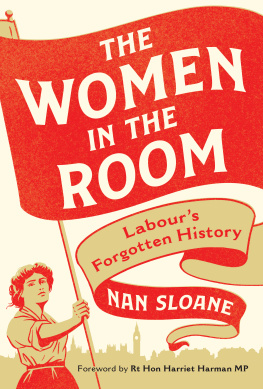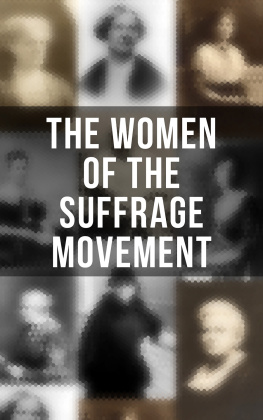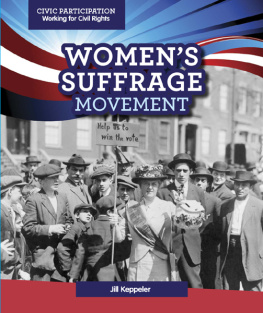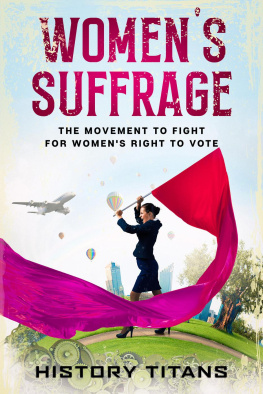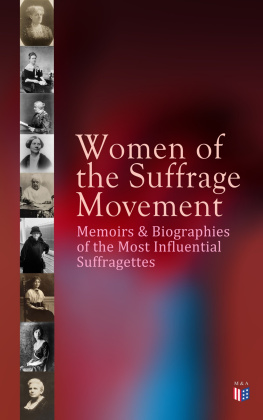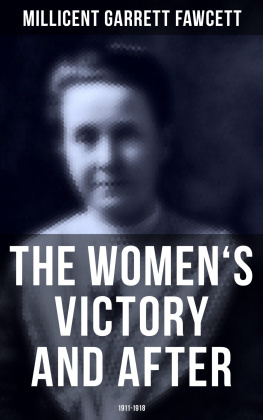Nan Sloane is a writer and activist with extensive experience of politics, feminism and the Labour Party. As the Director of the Centre for Women and Democracy she campaigned to increase womens participation in both civil society and politics, working with partners across the political spectrum. She has worked with women political activists in the Middle East, the Balkans and Africa and has trained hundreds of Labour women and public representatives in the UK. She is a long-standing member of Labour Womens Networks Management Committee and has a lifetimes experience of politics, including as a local councillor and a member of Labour Party staff. She is the editor of In Our Own Words: A Dictionary of Womens Political Quotations and A Great Act of Justice: The Flapper Election and After.
All too often the achievements of working-class women have been excluded from the history books. Yet it was these women who often fought the hardest and had the most to lose. It is up to us to bring to life the hidden history of working-class women and their great achievements. In this book, Nan Sloane takes up that challenge. She unearths the stories of women who, long before the campaign for womens suffrage, fought for workers rights and played a key role in the birth of the Labour Party. In doing so Nan rightfully honours those women who helped to lay the foundations for other working-class women to succeed.
Dawn Butler MP, Shadow Secretary of State for Women & Equalities
An absorbing insight into the role of women in British political history. Remarkable women across the Labour movement were busy influencing policy long before they could vote fighting for pay, working conditions, childcare, healthcare and social justice yet there is little trace of their existence. This highly readable, compelling book finally tells the story of these important hidden figures.
Ayesha Hazarika, political commentator and comedian
Nan Sloanes engaging book rebalances Labour Party history, putting women front and centre coincidentally where theyve always been, but often overlooked or erased. It is a refreshing and necessary change from the male-dominated history we tend to learn and is essential reading for everyone who values a full and equal perspective of the history of the Labour Party.
Amy Lam, writer, broadcaster and activist
Finally we can see some of the hidden history of our women. Working-class women and their role in politics has been and still is ignored. This book is the start of redressing this balance, and everyone should read it. We have got to stop forgetting the women from the past in the future!
Jess Phillips MP
In the immediate pre-war years the suffrage movement and the early Labour movement were intertwined. Yet this is little-known. Great, influential women who shaped twentieth-century politics and drove forward the campaign for the vote, rights at work, the early welfare state and much more have to date been largely airbrushed out of history. The Women in the Room sets the record straight.
Sam Smethers, Chief Executive, The Fawcett Society
Published in 2018 by
I.B.Tauris & Co. Ltd
London New York
www.ibtauris.com
Copyright 2018 Nan Sloane
The right of Nan Sloane to be identified as the author of this work has been asserted by the author in accordance with the Copyright, Designs and Patents Act 1988.
All rights reserved. Except for brief quotations in a review, this book, or any part thereof, may not be reproduced, stored in or introduced into a retrieval system, or transmitted, in any form or by any means, electronic, mechanical, photocopying, recording or otherwise, without the prior written permission of the publisher.
Every attempt has been made to gain permission for the use of the images in this book. Any omissions will be rectified in future editions.
References to websites were correct at the time of writing.
ISBN: 978 1 78831 223 3
eISBN: 978 1 78672 478 6
ePDF: 978 1 78673 478 5
A full CIP record for this book is available from the British Library
A full CIP record is available from the Library of Congress
Library of Congress Catalog Card Number: available
Text design, typesetting and eBook by BBR Design, Sheffield
eBook generated with BBR TextFlow
1786724782.20180831
Jacket design: Alice Marwick
Everywhere women have greater cause to cry for vengeance than men have, and that is why, even for a peaceful revolution such as trade unionism or socialism, the presence and influence of women is absolutely essential.
Isabella Ford
Contents
Guide
Illustrations
Foreword
Rt Hon Harriet Harman MP
The story of the foundation of the Labour Party is dominated by men such as Keir Hardie and Ramsay MacDonald. And behind them the hundreds of thousands of men trade unionists, the socialist organisations and Marxist parties. But throughout that time and woven through that struggle for progress, was the work of women and their organisations. This book makes visible the role of thousands of women, and their leaders, who otherwise remain hidden from history.
When you read this book you can only be incredulous about how partial and, for that reason, downright inaccurate our history is. Historians now who write about the men while completely ignoring the women who fought against poverty, for a minimum wage, for safety at work and to tackle infant mortality are perpetuating the sexism and discrimination those women suffered. We need positive action to redress this misrepresentation of our past. And this book is a major contribution to that as it reveals the work of a multitude of hitherto invisible women; women who were dedicated trade unionists and ardent members of the Labour Party.
Its quite simply a matter of historical accuracy which makes this book so necessary. I hope that what we will see is a major new genre of womens historical writing such as Rachel Reeves biography of Leeds MP Alice Bacon. As we cant leave it to men historians its something we women can and should do. And what we certainly shouldnt do is throw away our notes and records. My heart sank when I read in this book that the Womens Labour League destroyed many of its own records when it merged into the Labour Party. We must value what we do, keep our records and write about our own struggles to prevent ourselves being invisible to future generations. Most women get on with what they do, day to day. But at a time of struggle and change we need to know what previous generations of women did. And future generations will need to know what we are doing.
Most Labour members are familiar with the founding connection and the ongoing relationship between the trade unions and the Labour Party. But few will know that, just as working men were organising into trade unions to struggle for better terms and conditions, so too working women who were excluded from mens unions were setting up womens unions and forming the Womens Industrial Council. These womens unions not only defended women at work but they changed public policy. The National Federation of Women Workers, set up in 1906 by Mary Macarthur, led the strike of women chain-makers in 1910 which forced the implementation of the Trade Boards Act, the precursor of the National Minimum Wage. The womens unions fought on behalf of the women who were recruited into industry to replace men whod gone off to World War I, so that they would be safe and properly paid. It was only at the end of the war, by which time there were a million women in womens trade unions, that the mens trade union movement had to accept women into membership. They were allowed in but not welcomed with open arms.
The leading lights in the womens unions were also key in the quest for political progress, particularly through the Womens Labour League. Women couldnt participate in the meeting that founded the Labour Party and were only able to watch from the gallery. When the Womens Labour League was absorbed into the Labour Party the women were torn between conflicting loyalties between their commitment to the cause of women and their commitment to the Labour Party. The Party was a crucial force for social progress but was overwhelmingly masculine. Women could join at a reduced membership rate and that cemented their status as second-class members. But they were pivotal in striving for a whole raft of policies for which Labour women still campaign today. Their demand for free school meals was part of tackling poverty and improving public health and their campaigns for child health services contributed to the establishment of the National Health Service.
Next page
